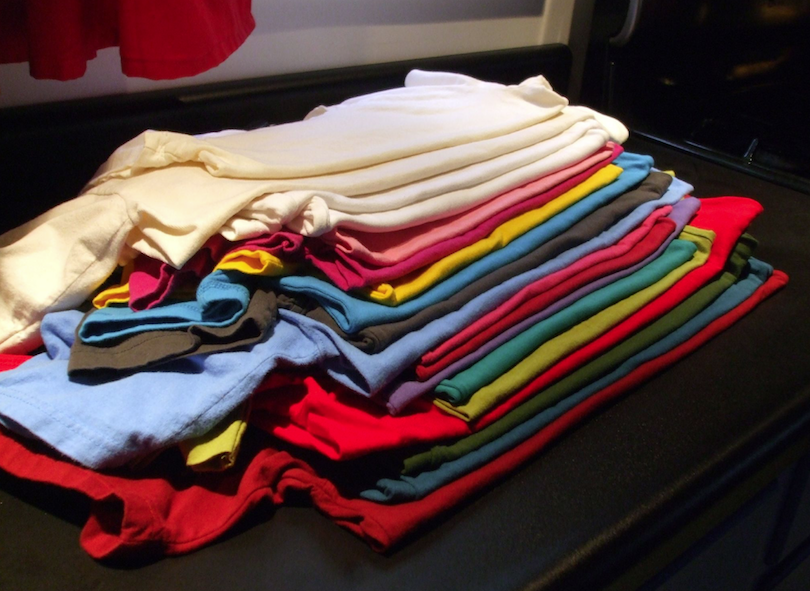
[Image above] Credit: Marcia Furman; Flickr CC BY-NC-ND 2.0
A shirt may no longer just be a shirt when it comes to the evolution of smarter textiles.
Sure, clothing as we know it serves an obvious dual purpose: it protects us from the surrounding environment and gives us a way to express our sartorial individuality. But researchers have set their sights on making our clothes do more.
From textiles that effectively dissipate body heat, to fabric that harvests energy from the sun, to computers sewn right into our sweaters, check out some of the latest innovations in “smart” clothing.
No A/C needed: Plastic-based clothing could help us keep our cool.
Stanford University researchers developed a new family of fabrics they say “could become the basis for garments that keep people cool in hot climates without air conditioning,” according to a university press release.
“If you can cool the person rather than the building where they work or live, that will save energy,” says Yi Cui, associate professor of materials science and engineering at Stanford.
Just like ordinary fabrics, the textile cools by letting perspiration evaporate through the material. But the material provides a second, revolutionary cooling mechanism: allowing heat that the body emits as infrared radiation to pass through the plastic textile.
By allowing the body to discharge heat both ways, such fabrics would make the wearer feel nearly 4°F cooler than if they wore cotton clothing. The new fabric is a three-ply material that consists of two sheets of treated polyethylene separated by a cotton mesh for strength and thickness—a formula the researchers say is definitely scalable.
The study, published in Science, is “Radiative human body cooling by nanoporous polyethylene textile” (DOI: 10.1126/science.aaf5471).
New fabric harvests energy from both sunshine and motion at the same time.
Fabrics capable of generating triboelectric power aren’t new to the scene—but researchers from Georgia Institute of Technology’s School of Materials Science and Engineering have taken this concept a step further.
The team combined two types of electricity generation into one textile that they say “paves the way for developing garments that could provide their own source of energy to power devices such as smartphones or GPS,” according to a Georgia Tech press release.
“This hybrid power textile presents a novel solution to charging devices in the field from something as simple as the wind blowing on a sunny day,” says lead researcher Zhong Lin Wang, professor materials science engineering at Georgia Tech.
The team used a commercial textile machine to weave together solar cells constructed from lightweight polymer fibers with fiber-based triboelectric nanogenerators, which use a “combination of the triboelectric effect and electrostatic induction to generate a small amount of electrical power from mechanical motion, such as rotation, sliding, or vibration,” the release explains.
The fabric, which is 320 micrometers thick woven together with strands of wool, could someday be integrated into tents, curtains, or wearable garments.
The study, published in Nature Energy, is “Micro-cable structured textile for simultaneously harvesting solar and mechanical energy” (DOI: 10.1038/nenergy.2016.138).
Clothes that compute could be the new fashion frontier.
Ohio State University researchers have embroidered circuits into fabric with 0.1 mm precision—the “perfect size to integrate electronic components such as sensors and computer memory devices into clothing,” according to a university press release.
“A revolution is happening in the textile industry,” says John Volakis, director of the ElectroScience Laboratory at Ohio State. “We believe that functional textiles are an enabling technology for communications and sensing—and one day even medical applications like imaging and health monitoring.”
The team uses threads that have a 0.1-mm diameter made with only seven filaments. Each filament is copper at the center, enameled with pure silver. To embroider a single broadband antenna, the team says, consumes about 10 feet of thread (which costs about 30 cents per antenna)—a process that has serious scale-up potential.
With further development, Volakis and his team say the technology could lead to shirts that act as antennas for smartphones, workout clothes that monitor fitness levels, bandages that track healing progress, and even a fabric cap that senses brain activity.
The study, published in IEEE Antennas and Wireless Propagation Letters, is “Fabrication of textile antennas and circuits with 0.1 mm precision” (DOI: 10.1109/LAWP.2015.2435257).
